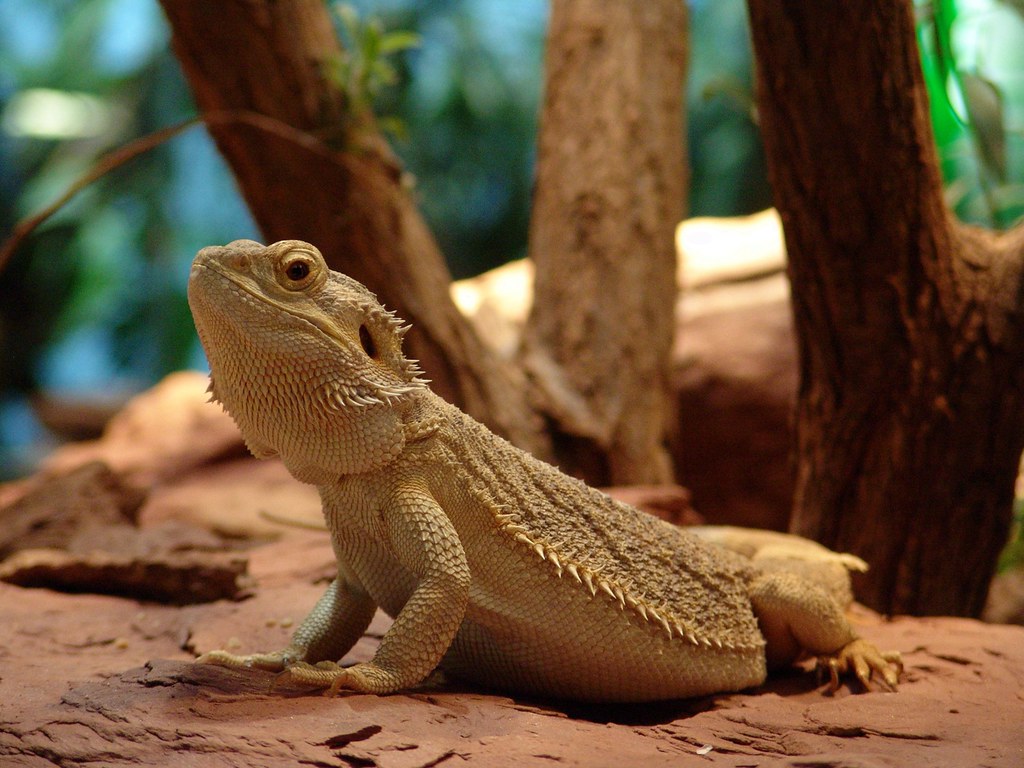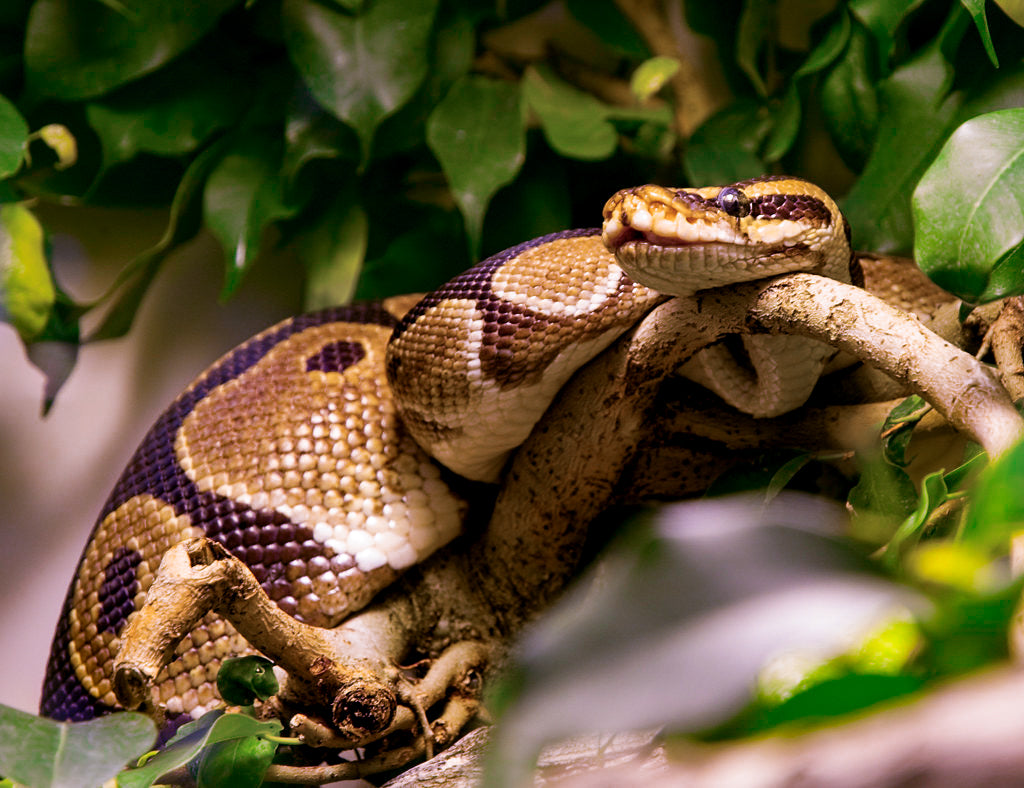Are you getting a pet bearded dragon? Bearded dragons can make great pets. However, as exotic animals, it’s important that they have an enclosure built to more or less replicate the conditions of their natural habitat. Otherwise, they can’t survive.
If you haven’t read our article “How to Care for Your Bearded Dragon” yet, start there. Once you’ve read that and have a basic understanding of what your bearded dragon needs from its environment, you’re ready to start setting up your bearded dragon enclosure.
Always set up a reptile enclosure well before you actually have the animal! This gives you more time to save up for the supplies you need, which in turn benefits your pet because you’re less likely to take shortcuts that may decrease its quality of care.
Step 1: Pick the Right Enclosure
Because bearded dragons can grow up to 24” long, they should have an enclosure that measures at least 48”L x 24”W x 24”H, with larger being preferable.
The enclosure can be made of wood, PVC, or plastic, but it should be front-opening and there should be a mesh top for ventilation. The mesh top is also important for easy placement of the lamps you will be using.
If the enclosure doesn’t have opaque sides, you will need to cover them with some kind of opaque material to help your bearded dragon feel secure in its environment. This can be as simple as construction paper or picture backdrop, or as elaborate as a 3D background.
Products we recommend:
Step 2: Set Up Lighting and Heating

For a bearded dragon, you need three types of lamps to help you replicate the effects of sunlight in their natural habitat:
- Heat
- UVB
- 6500K
The two heat lamps should be placed directly next to each other on the far right or left of the enclosure. The UVB lamp should be placed on the same end, very close to the heat lamps so the beams of light overlap. Then, place the 6500K on the same side, but because it’s longer than the other lamps, it will extend further along the length of the enclosure.
Products we recommend:
- Fluker's Mini Sun Dome Lamp, 5.5" (x2)
- Zoo Med Repti Tuff Splashproof Halogen Lamp, 90w (x2)
- Arcadia T5 HO Desert 12% UVB bulb, 22”
- Arcadia ProT5 Lamp Fixture, 24”
- Arcadia Jungle Dawn LED Bar, 34”
Step 3: Quarantine Period
Your bearded dragon will need to be quarantined for 3-6 months to make sure that it’s healthy. This involves fecal testing for parasites, administering medication as necessary, and generally monitoring the animal for concerning symptoms. It’s best to maintain fairly minimalistic conditions during this stage for easy cleaning, as having a fully set-up, naturalistic enclosure can make quarantine more of a hassle than it needs to be.
All you need equipment-wise for a quarantine setup is a basking platform/branch at the right height, two digital thermometers, food and water dishes, disposable or easily-cleaned substrate, and a hideout or cave.
Make sure the basking platform elevates the dragon to the appropriate distance from its back to the UVB lamp for correct levels of exposure, as UVB levels get stronger closer to the bulb, and if too close or too far away, the dragon may get dangerously high or low levels of UVB. It’s ideal to buy or borrow a Solarmeter 6.5 if you can to double-check your basking distance and the UVI that your dragon is being exposed to.
- Basking distance over mesh — 9-12”
- Basking UVI — 3.0-4.0
Place one digital thermometer so the probe is on the basking surface, and the other on the cool side of the enclosure. Temperatures should be as follows:
- Basking temperature— 108-113°F
- Cool zone temperature — 77-85°F
- Nighttime — 55-75°F
If your basking temperatures are too high, now is a good time to dial them down as needed with a plug-in lamp dimmer or proportional thermostat. If you need higher basking temperatures, you will need higher-wattage basking bulbs.
You will also need a good disinfectant to maintain sterile conditions during quarantine. This can be as simple as a bleach solution (¾ cup bleach per gallon of water) or veterinary-grade disinfectants like F10SC and Clean Break.
Products we recommend:
- Paper towels
- Zoo Med Repti Rock Food and Water Dishes, Medium
- Exo Terra Reptile Cave, Large
- Galapagos Staghorn Wood Manzanita Root Brown 13 In - 18 in
- Exo Terra Digital Combometer (x2)
- Zoo Med ReptiTemp Rheostat
Step 4: Add Substrate
Once your bearded dragon has passed quarantine, you can finish setting up its enclosure. While the first phase of setup was strictly practical, now you can get more creative in designing something that will not only be more functional for your bearded dragon to use, but also more attractive to look at. This starts with substrate.
Once your bearded dragon is out of quarantine, your best option for substrate is going to be a fine-particle naturalistic substrate such as sand or a 60/40 sand/soil mix. You will need at least 4” of substrate for a proper digging medium, so for a 48”x24”x24” enclosure, count on at least 80 quarts or 2.7 cubic feet of substrate.
For an enclosure with different dimensions, you can calculate the amount of substrate you’ll need by multiplying the length x width to get the number of cubic inches of substrate it will take for 1” deep of substrate. Then multiply that number by the desired depth of substrate, then convert the resulting number to quarts or cubic feet, depending on the metric you need.
Step 5: Add Decor
After you’ve laid down your substrate, replace the basking branch/platform, hide, and food/water dishes. Everything else is going to go around these staple items. This is the time to get creative! Try to more or less replicate the layout of a bearded dragon’s natural habitat as you arrange the decor. You can find habitat pictures on sites like iNaturalist and Flickr.
Make sure to keep your water bowl accessible and easy to remove, and to keep some open space available for the dragon to run around. Bearded dragons generally do well with a good amount of open space, as they don’t need as much clutter or available hidey-holes as other species.
Rocks
Stacking flagstones can make a nicely naturalistic basking platform. However, make sure to glue them together with cement or silicone so they don’t collapse and accidentally crush or injure your dragon.
Ledges
Magnetic ledges offer great lookout points for bearded dragons to survey their surroundings, and encourage climbing. Hammocks also offer a similar function. However, keep in mind that because they don’t absorb heat, hammocks make poor basking platforms.
You don’t have to worry too much about mold in the semi-arid environment of a bearded dragon terrarium, so your options for wood are pretty broad. Mopani wood, cork bark, grape vine, cholla wood, and manzanita wood can all work. Whichever you choose, make sure the branches are large enough to support your dragon’s size and weight.
Plants are a great way to make a bearded dragon enclosure more attractive, whether real or fake. However, keep in mind that because bearded dragons are omnivorous, they may try to take a bite out of any plants or plant-like objects you put in the enclosure.
Live plants should be kept in pots to help keep the water close to the roots, unless the enclosure is bioactive (which this article is not covering). Use drought-tolerant plants tolerant of higher ambient temperatures and moderate to high amounts of light. Some suitable options include:
- Air plant (Tillandsia)
- Agave
- Aloe
- Carex grass
- Elephant bush
- Festuca grass
- Gasteria
- Haworthia
- Hens and chicks (Echeveria)
- Ice Plant
- Jade plant (Crassula ovata)
- Prickly pear cactus (Opuntia danicolor) (spineless)
- Sempervivum
For more safe plant ideas, visit The Tortoise Table.
Conclusion
Even after you’ve set up your bearded dragon enclosure, don’t be afraid to continue to adjust the layout! Occasionally changing object placement or adding new things can stimulate your dragon to explore, and it’s always a good idea to adjust your bearded dragon’s enclosure as you continue to learn and understand bearded dragon husbandry better.
"pogona vitticeps" credited to Joachim S. Müller



Leave a comment
This site is protected by hCaptcha and the hCaptcha Privacy Policy and Terms of Service apply.